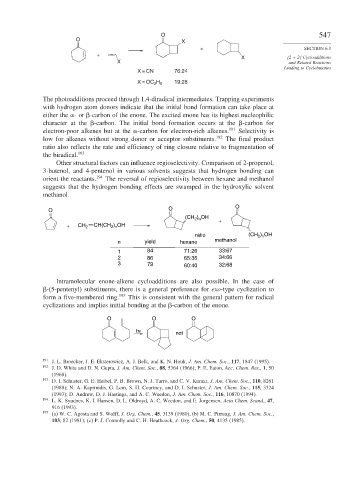Page 573 - Advanced Organic Chemistry Part B - Reactions & Synthesis
P. 573
O 547
O X
+ SECTION 6.3
+ X [2 + 2] Cycloadditions
X and Related Reactions
Leading to Cyclobutanes
X = CN 76:24
X = OC H 19:28
2 5
The photoadditions proceed through 1,4-diradical intermediates. Trapping experiments
with hydrogen atom donors indicate that the initial bond formation can take place at
either the -or -carbon of the enone. The excited enone has its highest nucleophilic
character at the -carbon. The initial bond formation occurs at the -carbon for
electron-poor alkenes but at the -carbon for electron-rich alkenes. 191 Selectivity is
low for alkenes without strong donor or acceptor substituents. 192 The final product
ratio also reflects the rate and efficiency of ring closure relative to fragmentation of
the biradical. 193
Other structural factors can influence regioselectivity. Comparison of 2-propenol,
3-butenol, and 4-pentenol in various solvents suggests that hydrogen bonding can
orient the reactants. 194 The reversal of regioselectivity between hexane and methanol
suggests that the hydrogen bonding effects are swamped in the hydroxylic solvent
methanol.
O O O
(CH ) OH +
2 n
+ CH 2 CH(CH ) OH
2 n
ratio (CH ) OH
2 n
n yield hexane methanol
1 84 71:26 33:67
2 86 65:35 34:66
3 79 60:40 32:68
Intramolecular enone-alkene cycloadditions are also possible. In the case of
-(5-pentenyl) substituents, there is a general preference for exo-type cyclization to
form a five-membered ring. 195 This is consistent with the general pattern for radical
cyclizations and implies initial bonding at the -carbon of the enone.
O O O
hν
not
191 J. L. Broecker, J. E. Eksterowicz, A. J. Belk, and K. N. Houk, J. Am. Chem. Soc., 117, 1847 (1995).
192 J. D. White and D. N. Gupta, J. Am. Chem. Soc., 88, 5364 (1966); P. E. Eaton, Acc. Chem. Res., 1,50
(1968).
193
D. I. Schuster, G. E. Heibel, P. B. Brown, N. J. Turro, and C. V. Kumar, J. Am. Chem. Soc., 110, 8261
(1988); N. A. Kaprinidis, G. Lem, S. H. Courtney, and D. I. Schuster, J. Am. Chem. Soc., 115, 3324
(1993); D. Andrew, D. J. Hastings, and A. C. Weedon, J. Am. Chem. Soc., 116, 10870 (1994).
194 L. K. Syudnes, K. I. Hansen, D. L. Oldroyd, A. C. Weedon, and E. Jorgensen, Acta Chem. Scand., 47,
916 (1993).
195
(a) W. C. Agosta and S. Wolff, J. Org. Chem., 45, 3139 (1980); (b) M. C. Pirrung, J. Am. Chem. Soc.,
103, 82 (1981); (c) P. J. Connolly and C. H. Heathcock, J. Org. Chem., 50, 4135 (1985).

